History
Gibson’s Les Paul Standard model from 1959 is the most highly acclaimed, widely recognized solid body electric guitar in the entire world, coveted by both players and collectors as the ultimate example of playability, attractiveness and tone among all six-stringed instruments. In an industry filled with imitations and replicas, the iconic 1959 Les Paul Standard simply has no equal.
Named after Lester William Polsfuss, aka Les Paul – legendary American jazz guitarist, and true pioneer in the development of recorded music – the Les Paul model guitar became the “Standard” in July 1958 after company president Ted McCarty and his staff decided to add the new designation and forego the guitar’s traditional Goldtop finish for a new, brighter finish dubbed Cherry Sunburst, which allowed the natural beauty of the Les Paul Standard’s maple top to be showcased. The company was hoping the changes would improve its sales of solid body electric guitars, which had been declining since 1953 when the Gibson shipped 2,245 Les Paul Model guitars.
Unfortunately, sales of the new Les Paul Standard continued to dip, and after shipping only 643 guitars in 1959 and another 635 during the early part of 1960, Gibson once again instituted another redesign of the guitar, abandoning the Les Paul design as we know it today and creating the SG Standard. No one could have imagined, however, that those 1,278 Les Paul Standard guitars – especially the 643 from 1959 – would become the most sought after guitars in the world.
Body
While the full impact of the 1959 Les Paul Standard was still several years away from being realized, its influence on guitar design was already well underway. Besides its exceptional tone and playability, the 1959 version of the Les Paul Standard was renowned for its two “bookmatched” pieces of maple wood that made up the top of the guitar. While most of the Les Paul Standard tops in 1958 were considered “plain,” some of the maple tops in 1959 – and into 1960 – were “flamed” or “figured,” adding a three-dimensional, cosmetic element never before seen on any solid body guitar. The beautiful patterns, however, went largely unnoticed at the time, with Gibson paying no particular attention to selecting wood with distinct grain patterns. Other cosmetic changes on the 1959 Les Paul Standard included a slightly thinner neck profile, a smaller heel, and a change to larger “jumbo”-sized frets, which are still in use today.
Finish
The guitar’s new Cherry Sunburst finish also saw its first full year of use in 1959, despite problems with the consistency of the red pigment used to paint it – a problem that wasn’t corrected until late 1960. This caused the finish on many guitars to fade to some degree of amber, honey or yellow hue, further adding to the beauty and mystique of the instrument.
Famous Players
One of the first guitarists to recognize the potential of the 1959 Les Paul Standard was The Rolling Stones’ Keith Richards, who obtained a 1959 model in 1964 that had been outfitted with a Bigsby tremolo tailpiece. Around 1966, emerging British guitarist Eric Clapton – himself influenced by the early 1950s Les Paul models played by Freddie King and Hubert Sumlin – also recognized the Les Paul Standard’s exceptional tone and playability, and began playing them almost exclusively. Before long, the Les Paul Standards of the late 1950s had found their way into the hands of future guitar legends Jimmy Page, Jeff Beck, Duane Allman, Peter Green and Michael Bloomfield, among others, eventually helping to reshape the sound of a worldwide musical movement, while forever changing the standard by which all other electric guitars are measured.
Near-perfect Recreation
The 1959 Les Paul Standard reissue produced today by Gibson Custom is true to all of the original instrument’s features and characteristics, including Gibson’s traditional hand-carved “figured” maple top and solid, non-weight relieved mahogany body. The headstock is made from Holly head veneer, as opposed to fiber, just like it was in 1959, and the vintage-style tulip tuners are mounted in a straight line, also as they were on the original. The 24 ¾-inch scale length neck is made from one solid piece of mahogany, and attached to the body using a long neck tenon — one of the Les Paul’s more distinguishing characteristics of the 1950s. The neck is topped by a 22-fret rosewood fingerboard outfitted with acrylic trapezoid inlays matching the size and color of the originals. Of course, two of Gibson’s legendary Burstbucker pickups deliver all the subtle variations of true, classic “Patent Applied For” humbucker tone by using historically “unmatched” bobbin windings and Alnico II magnets. Other historical appointments include CTS potentiometers, bumble bee capacitors, rolled crème-colored fingerboard binding, single-ply crème-colored binding around the body, and a period-correct thin toggleswitch washer and jackplate. The 1959 Les Paul Standard comes in either a V.O.S. or Gloss finish, and with the standard Gibson Custom case and certificate of authenticity. They are available in Faded Tobacco Burst, Washed Cherry Burst and Iced Tea Burst.
Your shopping cart is empty!
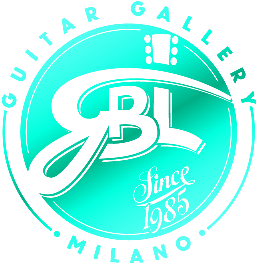
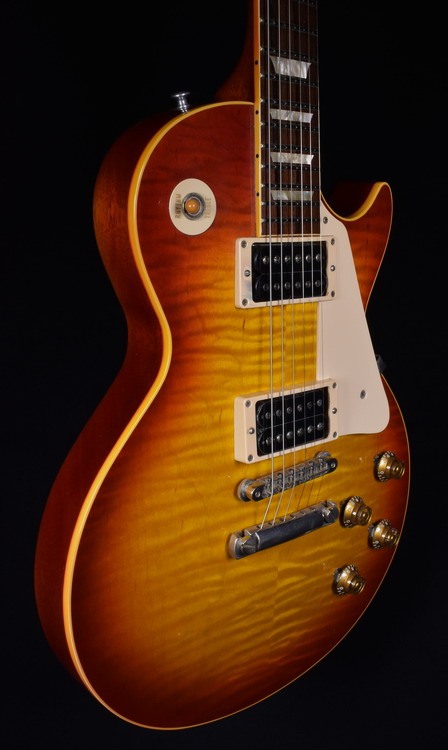
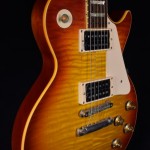
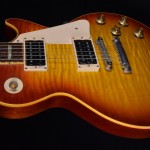
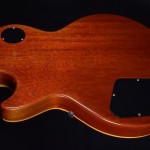
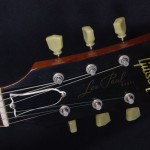
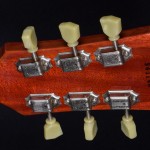
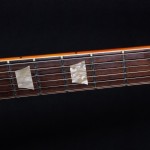
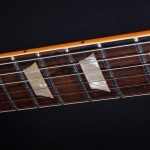

Be the first to review “SOLD GIBSON LES PAUL HISTORIC 59 REISSUE 2004”
Devi essere connesso per inviare un commento.